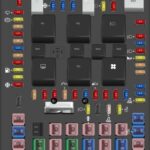Experiencing a check engine light in your 2000 Honda Civic can be concerning, but diagnosing the issue doesn’t always require an expensive OBD2 scanner. For owners of this generation Civic, there’s a straightforward method to retrieve diagnostic trouble codes (DTCs) using just a simple jumper wire. This guide will walk you through the process step-by-step, allowing you to understand what your Civic is trying to tell you, even without specialized equipment.
Step-by-Step Guide to Reading CEL Codes on a 2000 Civic
This procedure leverages the Civic’s built-in diagnostic capabilities to flash the check engine light (CEL) in patterns that correspond to stored DTCs. By carefully observing these flashes, you can decipher the codes and pinpoint potential problems.
Step 1: Prepare Your Vehicle
First, ensure your 2000 Honda Civic’s engine is completely turned OFF. Locate the 16-pin OBDII Data Link Connector (DLC). In 2000 Civics, this connector is typically found under the driver’s side dashboard, often in the area above your right knee when seated in the driving position.
Step 2: Get Your Jumper Wire Ready
You’ll need a small jumper wire. A paperclip or a short length of wire with exposed ends will work. This wire will bridge two specific terminals within the DLC, allowing you to access the diagnostic system.
Step 3: Connect the Terminals
This is a crucial step. Carefully identify terminals 4 and 9 on the DLC. Refer to a DLC pinout diagram if you are unsure of the terminal locations to avoid any mistakes. Using your jumper wire, connect terminal 4 to terminal 9. It is extremely important to double-check that you are connecting the correct terminals. Incorrect connections can lead to electrical damage to your car’s Engine Control Unit (ECU).
Step 4: Turn the Ignition ON
Insert your key into the ignition and turn it to the “ON” position (position II). This powers up the vehicle’s electrical system and ECU, but do not start the engine.
Step 5: Observe the Check Engine Light (CEL) Flashes
Now, watch the check engine light on your dashboard closely. It will begin to flash in a specific sequence. This flashing pattern represents the stored DTCs.
- Long Flashes: Indicate the first digit of the code.
- Short Flashes: Indicate the second digit of the code.
- Brief Pause: Represents a zero (0).
For example:
- Four long flashes followed by five short flashes represents code 45.
- One long flash followed by a pause represents code 10.
If multiple DTCs are stored, the CEL will display each code in sequence, and then repeat the entire sequence. Carefully record each code as it is displayed, and repeat the process to double-check your readings.
Step 6: Interpret the Diagnostic Trouble Codes (DTCs)
Once you have recorded the flashed codes, you’ll need to look up their meaning. These one- or two-digit CEL codes correspond to more detailed four-digit OBDII codes. You can find resources online that list Honda-specific DTC codes for 2000 Civics. Search for “Honda DTC index” or “OBD1 to OBD2 code conversion Honda” to find charts that will help you interpret the codes you retrieved.
Clearing the Check Engine Light Codes (Optional)
If you wish to clear the stored DTCs and reset the ECU after noting them down (or after addressing the issue), you can do so by removing the #6 fuse (15A) from the under-hood fuse box for at least 10 seconds.
However, if you plan to take your Civic to a professional mechanic for diagnosis and repair, it is generally advisable to leave the DTCs stored in the ECU. This allows the mechanic to use their professional OBDII scan tools to further diagnose the problem and verify the codes you retrieved using the jumper wire method. Providing the mechanic with the codes you’ve already obtained can also save time and assist in a quicker diagnosis.
By following these steps, you can effectively diagnose a check engine light on your 2000 Honda Civic without needing an OBD2 scanner, giving you a valuable starting point for understanding and addressing any potential issues.

